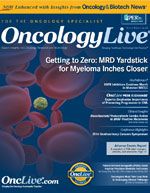Timing Is Everything
As anticancer therapies continue to improve outcomes for patients, questions about how best to deploy these new options abound. In this issue of OncologyLive, we explore two of the pressing questions that have arisen in treating patients with hematologic malignancies.
OncLive Chairman,
Mike Hennessy
As anticancer therapies continue to improve outcomes for patients, questions about how best to deploy these new options abound. In this issue of OncologyLive, we explore two of the pressing questions that have arisen in treating patients with hematologic malignancies:
In multiple myeloma, when has a patient reached minimal residual disease (MRD) status and what are the treatment implications of an MRDzero test score? In chronic myeloid leukemia (CML), which of the array of tyrosine kinase inhibitors (TKIs) is the optimal choice for frontline therapy and when is it appropriate to switch to a different drug?
Let’s establish at the outset that these are good problems to confront. It wasn’t that many years ago that patients with these malignancies did not live long enough for their doctors to even consider weighing such options.
Now, however, the prospect of long-term survival and, in the case of myeloma, perhaps even a cure has made these complex matters of vital importance.
In our cover story, “Getting to Zero: MRD Yardstick for Myeloma Moves Closer,” leading researchers describe efforts to develop validated test instruments that can detect 1 leukemic cell in a million. Once these assays are ready for clinical use, the question for many patients with myeloma will likely revolve around how aggressive their treatment should be and when it could be safely interrupted or discontinued.
In our OncLive Peer Exchange report, “Experts Emphasize Importance of Preventing Progression in CML,” the esteemed panelists agree that attacking CML early with more effective second-generation TKIs is the strategy most likely to deliver the best outcomes. Major oncology associations already have developed monitoring protocols for CML, although the panel discussion highlights some of the nuances of implementing those practices.
In tackling these questions, it sometimes seems as though we are pondering an origami sculpture— an intriguing shape consisting of elements that are revealed in the unfolding. It is tempting sometimes to wonder whether we will “solve” the mysteries of cancer.
In this era of vigorous discovery, however, we are quite confident that much progress is being made. Please let us know your thoughts on these developments and, as always, thank you for reading.




